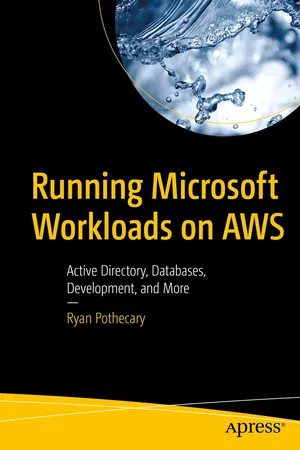
Running Microsoft Workloads on AWS
Active Directory, Databases, Development, and More
- English
- ePUB (mobile friendly)
- Only available on web
About This Book
Did you know that Amazon Web Services runs nearly double the amount of Microsoft Workloads in the cloud than any other provider?
Running Microsoft Workloads in AWS is your single-source solution for learning the best practice skills and guidance that AWS consultants offer their customers in the field. Over 70% of enterprise workloads are based on Microsoft technologies and AWS has been running these technologies in the AWS Cloud for more than 12 years—far longer than Microsoft's own Azure cloud platform.
This book introduces AWS foundations and compares them to traditional Microsoft architectures, showing you how to design your AWS Cloud platform to run your current Microsoft solutions. It covers the crucial area of identity and access control, showing how to implement Active Directory inside the AWS platform and the most secure ways of enabling Single Sign On from your own data centers and from Microsoft AzureAD.
The book goes in-depth and shows how developers across the globe are using their existing.NET skills to develop directly on top of AWS, using current AWS development services such as AWS Code Pipeline, AWS Code Build, and AWS Code Deploy to create the next generation of cloud-native applications using the most popular cloud serverless service—AWS Lambda.
What You Will Learn
- Be familiar with the basic building blocks of AWS and how the terminology differs from your own data center and Microsoft Azure
- Understand Amazon Machine Images (AMI) strategies and solutions to best manage the trade-off between speed and manageability
- Run one of the most popular Microsoft products: SQL Server on AWS
- Be aware of the different database architecture designs for using Amazon RDS and Amazon EC2
- Read an overview of Serverless Development in the AWS cloud from a Microsoft.NET perspective
- Know migration strategies for moving your Microsoft Workloads tothe AWS Cloud
Who This Book Is For
Covers high-level concepts and solutions for CTOs and CCTOs; provides a solution for architects; and dives deep into the topic for administrators and DevOps engineers
Frequently asked questions
Information
Table of contents
- Cover
- Front Matter
- 1. Wait, I Can Run Windows on AWS?
- 2. AWS 101
- 3. Server
- 4. Databases
- 5. Developing on AWS
- 6. Serverless
- 7. Containers
- 8. Operational Integration
- 9. Migration
- 10. Identity
- Back Matter